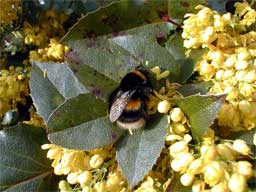Gardens can offer good habitat for a number of insects, including that most beneficial group of insects, bees. Most adult insects depend on flowers for nectar, but bees collect pollen to feed their young as well, and in doing so pollinate the flowers. Most people think of honeybees here, but these are actually less useful in this respect than bumblebees and solitary bees, which pollinate a much wider range of flowers.
Bumblebees – in decline
Like honey bees, bumblebees live together as a colony and cooperate to raise their young — they are social insects. The colony always centres on the queen, who lays eggs most of which develop into workers. The workers look after the queen, and help to raise more young and build up the colony. A colony of honey bees may run into tens of thousands but colonies of bumble bees are much smaller – 200 workers at most. Unlike honey bees, which survive the winter as a colony, bumblebee colonies die out in the summer or early autumn and only the young queens raised towards the end of the summer survive, hibernating through the winter and waking up in spring to found a new colony from scratch.
Bumblebees often nest in gardens, under shed floors and under decking being favourite spots. They are docile and unaggressive creatures even near the nest, so no more a threat to children or pets when they nest in your garden than if just visiting the flowers. Curiosity may lead them to inspect you in case you might be a source of food, but he commonest reason for stings is self-defence such as when bees are trodden on or squashed by mistake.
Only six bumblebees remain widespread in Britain, and these are nowadays often more abundant in gardens than in the agricultural countryside, visiting flowers for nectar and pollen. However even these common bumblebees tend to collect pollen from a rather restricted range of plants, and you can help them by growing the right flowers. Some particularly useful plants to grow are listed here.

Artificial homes
All bumblebees need for a nest site is a waterproof, well insulated, undisturbed space about the size of a football. They will adopt any suitable spot that is accessible, including in a roof, under a shed or decking, in a loose, dry compost heap or in an old mouse nest underground. Occasionally they will use birdboxes, especially those that have been used by mice over the winter.
To create an artificial nest bury a large clay plantpot in the ground with a 25mm pipe or hose running from the drainage hole to the surface. Or you can make a box about 20cm high and wide and 35cm long, divided into two about a third of the way along. Drill 25mm entrance holes through the smaller compartment, plus a few ventilation holes covered with mesh in the main compartment. If you want to see what is going on inside, make the lid out of perspex. Commercial bumble boxes are available also.
Provide some nesting material as bumbles do not bring in material but use what they find. An old mouse nest is ideal if you can find one, or if not shredded newspaper or kapok (but not cotton wool which gets tangled around their legs). Put the box in a sheltered spot in the garden covered with roof tiles or slates to keep out the rain.
